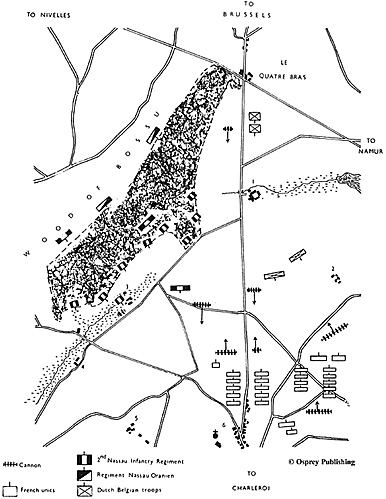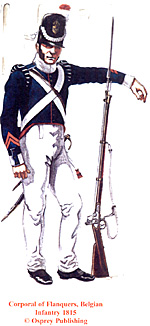The Netherlands Victory
Quatre Bras 1815
Introduction
by Peter Hofschröer, Germany
| |
The Monument at Quatre Bras - photographed in 1995 © David Watkins
It reads, ‘… [Wellington] whispered to ask him [Richmond] if he had a good map in his house. The Duke of Richmond said he had, and took him into his dressing-room, which opened into the supper-room. The Duke of Wellington shut the door and said, “Napoleon has humbugged me (by God), he has gained twenty-four hours’
march on me.” The Duke of Richmond said, “What do you intend doing?” The Duke of Wellington replied, “I have ordered the army to concentrate at Quatre-Bras; but we shall not stop him there, and if so I must fight him here" (at the same time passing his thumbnail over the position of Waterloo).’
[1]
Wellington was not only a military genius, but also clairvoyant, as are all great Englishmen. Furthermore, Wellington told us in his ‘Waterloo Despatch’ of 19 June 1815 that before the commencement of the Battle of Quatre Bras ‘I had directed the whole army to march upon Les Quatre Bras’ . [2]
Wellington claimed in his ‘Waterloo Memorandum’ of 1842 that by 3 AM on 16 June, ‘he was at Quatre Bras … with a sufficient force to engage the left of the French army’. [3]
British Waterloo historians consider this sufficient to present as fact Wellington’s assertion to have intended to fight a battle at Quatre Bras and ordered his
entire army there. What reasonable person could dispute this, particularly as Tennyson’s immortal lines in his ‘Ode on the Death of the Duke of Wellington’ wax
lyrical about the Great Duke’s probity [4]?
Shall we throw light on the record? Let us start with the relevant volume of Wellington’s Dispatches, published in 1838. It contains the first orders issued between 6
and 7 PM on 15 June 1815. The information Wellington had received from the front by then was that the French had commenced hostilities, attacking the Prussian outposts around Charleroi. He had no information on the size and intentions of this force. That being the case, the logical course of action was to concentrate his army
and await developments, which is what he did.
General Dornberg’s brigade of cavalry, and the Cumberland Hussars, to march this night upon Vilvorde, and bivouac on the high road near to that town. The Earl of Uxbridge will be pleased to collect the cavalry this night at Ninhove, leaving the 2nd hussars looking out between the Scheldt and the Lys.
The 1st division of infantry to collect this night at Ath and adjacent, and to be in readiness to move at a moment’s notice. The 3rd division to collect this night at
Braine le Comte and to be in readiness to move at the shortest notice. The 4th division to be collected this night at Gramont, with the exception of the troops beyond the Scheldt which are to be moved to Audenarde.
The 5th division, the 81st regiment, and the Hanoverian brigade of the 6th division, to be in readiness to march from Bruxelles at a moment’s notice. The Duke of Brunswick’s corps to collect this night on the high road between Bruxelles and Vilvorde. The Nassau troops to collect at daylight tomorrow morning on the Louvain
Road, and to be in readiness to move at a moment’s notice.
The Hanoverian brigade of the 5th division to collect this night at Hal, and to be in readiness at daylight tomorrow morning to move towards Bruxelles, and to halt on the high road between Alost and Assche for further orders.
The Prince of Orange is requested to collect at Nivelles the 2nd and 3rd divisions of the army of the Low Countries; and, should that point have been attacked this
day, to move the 3rd division of British infantry upon Nivelles as soon as collected.
This movement is not to take place until it is quite certain that the enemy’s attack is upon the right of the Prussian army, and the left of the British army. Lord Hill will be so good as to order Prince Frederick of Orange to occupy Audenarde with 500 men, and to collect the 1st division of the army of the Low Countries, and the Indian brigade at Sotteghem, so as to be ready to march in the morning at daylight. The reserve artillery to be in readiness to move at daylight. [5]
The next orders, the ‘after orders’, were timed at 10 PM. Wellington issued these orders after hearing that Blücher was concentrating his army in the Sombreffe position. The Duke had yet to receive further information on the French movements and intentions. The logical course of action was to close up on Blücher, which is what he did. The ‘after orders’ read,
The 3d division of infantry to continue its movement from Braine le Comte upon Nivelles. The 1st division to move from Enghien upon Braine le Comte.
The 2nd and 4th divisions of infantry to move from Ath and Grammont, also from Audenarde, and to continue their movements upon Enghien. The cavalry to continue its movement from Ninhove upon Enghien. The above movements to take place with as little delay as possible. [6]
It is evident that on the evening of 15 June, Wellington had not ordered a single man to Quatre Bras. In fact, the only time Wellington mentioned Quatre Bras was
when he ordered the troops there to abandon this position. Let us now endeavour to run down and establish the facts: What did happen that evening at Quatre Bras and why was Wellington able to fight a battle there on 16 June?
More Netherlands Victory Quatre Bras 1815
Related
Quatre Bras 16th June 1815 [FE59]
|

 Waterloo aficionados will remember that dramatic scene in the 1970 Dino de Laurentiis film where during the Duchess of Richmond’s ball, Wellington tells his staff he will fight at Quatre Bras, but would not be able to hold Napoleon there. Instead, he would stop Napoleon at Waterloo. This scene is based on Captain George Bowles’ account of a conversation reported to have taken place between Wellington and the Duke of Richmond at the ball.
Waterloo aficionados will remember that dramatic scene in the 1970 Dino de Laurentiis film where during the Duchess of Richmond’s ball, Wellington tells his staff he will fight at Quatre Bras, but would not be able to hold Napoleon there. Instead, he would stop Napoleon at Waterloo. This scene is based on Captain George Bowles’ account of a conversation reported to have taken place between Wellington and the Duke of Richmond at the ball.
 These orders read,
These orders read,
 Corporal of Flanquers, Belgian Infantry 1815 © Osprey Publishing.
Corporal of Flanquers, Belgian Infantry 1815 © Osprey Publishing.